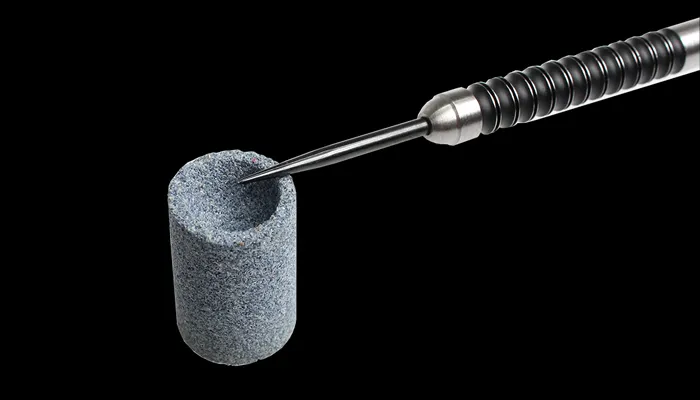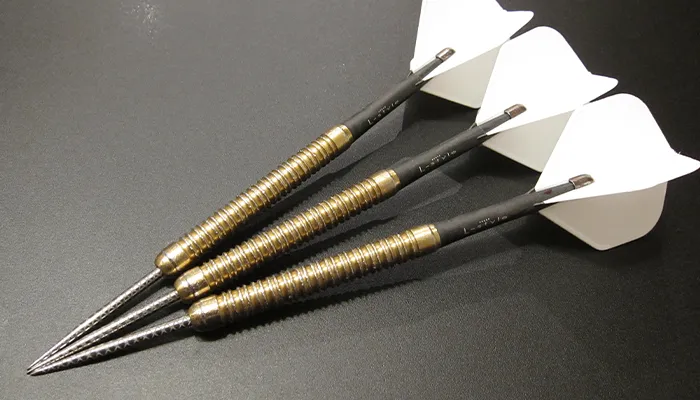You finally invested in a high-quality set of darts and a professional dartboard, so now it’s time to make sure those tungsten tips are razor-sharp for optimal performance. Dull darts just won’t cut it if you want to start throwing tight groupings and hitting those triple-20s with consistency.
Sharpening darts is a straightforward process, but there are a few key tips and tricks to know to get your darts competition-ready. In just a few minutes, you can have your darts slicing through the air and sticking right where you aim them.
So grab your darts, a few basic tools, and let’s get those points needle sharp. By the time we’re finished, your darts will be piercing the board with precision and ease, allowing your skills to shine through. The bullseye won’t know what hit it!
The Importance of Proper Dart Sharpening
Proper dart sharpening is key to peak performance and accuracy. Dull darts won’t grip the board well and can slip right out, ruining your shot.
The Points
The points on your darts take the most abuse, so sharpening them regularly is a must. Use a dart point sharpener, file, or fine grit sandpaper and gently roll the point against the sharpener using even pressure. Check your progress often by lightly dragging the point across your fingernail – it should catch slightly when sharp.
Be extremely careful not to over-sharpen, as this can weaken the point. For safety, only sharpen in short bursts, checking frequently. Overly sharp points can also damage your dart board.
The Barrels
While less frequent, barrel sharpening is also important. As barrels get dull, darts won’t grip the board as well and your shots will suffer. Use ultra-fine grit sandpaper and roll the barrel against it using even pressure. Wipe away filings with a soft cloth. Check your work with a fingernail drag test.
Keeping your darts sharp and in peak condition is essential to consistent accuracy and performance. With regular sharpening and maintenance, your darts will fly fast, straight and true. Game on!

Supplies You’ll Need for Sharpening Darts
To sharpen your darts, you’ll need a few essential supplies.
Sharpening Stone
A sharpening stone is a must-have. Look for a fine grit stone (around 600 grit) that can handle the point of a dart. A diamond stone works well and lasts longer than natural whetstones.
Guide
A sharpening guide helps you maintain the proper angle as you slide the dart along the stone. It takes the guesswork out of sharpening and helps you get razor-sharp points.
Lubricant
Add a few drops of honing oil or water to the stone. The lubricant prevents metal filings from building up as you sharpen. It also helps the dart glide smoothly across the stone.
Magnifying Glass (Optional)
A magnifying glass or magnifying headset lets you closely inspect the point to ensure it comes to a fine, symmetrical point. For the best results, examine your progress frequently as you sharpen.
With the right supplies and some patience, you’ll have your darts sharpened to a competition-ready point in no time. Your precision and accuracy will improve dramatically, allowing you to achieve peak performance during your matches.

Step-by-Step Guide to Sharpening Darts
To get your darts razor sharp and flying straight, you’ll need to invest in a quality dart sharpener and spend a few minutes sharpening the points. Follow these steps:
Gather Your Supplies
You’ll need your set of darts, a dart sharpener, and a magnifying glass or jeweler’s loupe. Look for a sharpener designed specifically for sharpening darts.
Inspect the Points
Closely examine the points of each dart under magnification. Check for any burrs, dents, or imperfections before sharpening. Gently file down any issues with fine-grit sandpaper.
Secure the Sharpener
Place your sharpener on a level, secure surface like a table or countertop. Holding the sharpener in one hand can lead to uneven sharpening.
Guide the Dart Through
Slowly and evenly pass the dart point through the sharpener using light pressure. Make multiple passes, checking your progress with each pass. It’s best to take your time—rushing can lead to an uneven point or the dart slipping.
Test and Repeat
Gently test the point of the dart with your finger to check if it’s sharp. If needed, make additional passes through the sharpener. Be very careful, as the points will be extremely sharp! Repeat with all darts until the points are needle-sharp.
Protect the Points
Store your darts point down or in a case to protect the newly sharpened points. Your darts will now fly fast and true, allowing you to achieve peak performance. With regular sharpening and practice, you’ll be hitting those bullseyes in no time!

Things To Avoid
While sharpening your darts is important for performance, there are a few things you want to avoid doing:
Using a Grinder
Stay away from using an electric grinder to sharpen your darts. Grinders can damage the dart tip and ruin its shape. They also create too much friction and heat, which can warp the dart.
Sharpening Too Much
It’s easy to get overzealous when sharpening, but removing too much material from the dart tip is counterproductive. Only sharpen until you’ve restored the point, then stop. Taking off excess amounts of metal weakens the tip and negatively impacts dart stability in flight.
Uneven Sharpening
Make sure to sharpen your darts evenly by using the same number of strokes on each flat of the tip. Uneven sharpening causes the dart to fly off course, as the uneven weight distribution will cause it to pull to one side. Take your time and be methodical.
Forgetting the Barb
The barb, or dart point, also needs occasional sharpening. Use small needle files to sharpen the barb, being very careful not to break it off. A sharp barb helps the dart stick in the board, so don’t neglect this important part of the tip.
By avoiding these common mistakes, you’ll achieve peak performance from your darts and be throwing tight groupings in no time. With regular practice and the proper technique, you’ll be hitting bullseyes and throwing like a pro.
FAQs
With any hobby, questions tend to come up. Here are some of the most frequently asked questions about dart sharpening and their answers:
Conclusion
So there you have it, everything you need to know to get your darts razor sharp and flying straight. By now, you should feel fully equipped to achieve peak dart performance. Take your time, be patient through the process, and remember that practice makes perfect. Your skills and technique will improve over time.
Before you know it, you’ll be throwing tight groupings and hitting those triple 20s with ease. Stay focused, keep a steady hand, and keep putting in the effort to refine your game. With sharp darts and consistent practice, the sky’s the limit for how good you can get. You’ve got this – now get out there and throw! The bullseye is waiting.

